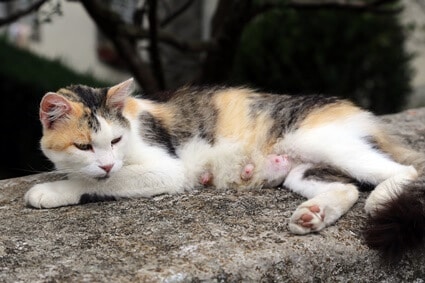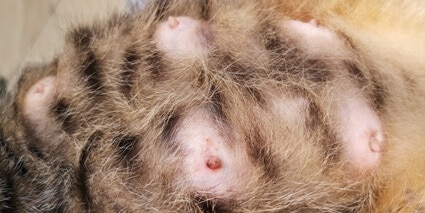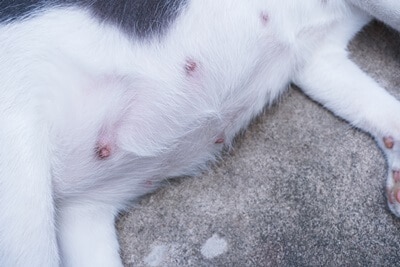Most people have never seen a cat’s nipples, let alone know what they look like. A cat’s nipples are found in 2 rows, about 1 inch above the pelvis. Cats can have between 2 and 10 nipples, but the number varies between cats.
Normal cats’ nipples are small and pink, but they shouldn’t be prominent unless the cat’s pregnant. While a cat carries her litter, the nipples may become plumper and brighter in color. If a female cat isn’t pregnant or in heat, she could have a swollen cyst, mammary cancer, or mastitis.
You should occasionally check your cat’s nipples by touch. As they’re so small, you can’t always identify a problem by sight alone. However, the nipples of a healthy cat won’t be sore to the touch.
How Many Nipples Do Cats Have?
As stated above, cats can have anywhere from 2 to 10 nipples, but there’s no hard-and-fast rule. The total number of nipples is usually even, but it can vary.
More nipples are advantageous for female cats. The more nipples she has, the larger a litter she can nurse at the same time. The average litter is 2-5 kittens, so a cat with 6 nipples can ensure that no kitten goes hungry.
How Should Cat Nipples Look?
Cats’ nipples closely resemble pimples: they’re small, pink, and bumpy. It can be hard to locate them, especially the nipples on male felines, especially as they’ll be covered by fur.
If you can’t find your cat’s nipples, this doesn’t mean that your cat has no nipples. They have just not been used and are less significant. All healthy nipples on cats look the same, regardless of a cat’s gender, age, or breed.
Nipple irritation could be a sign of ill health. Things to look out for include:
- Crusty nipples
- Chapped nipples
- Sores around the nipples
These are signs of infection, which can be an issue among cats that have recently given birth as a nursing cat could pass on an infection to her young.
Why are My Cat’s Nipples Swollen?
Here are the causes of swollen nipples in cats:
- Pregnancy or in-heat
- Mastitis
- Mammary Cancer
Mammary cancer is a risk in mature, unspayed females.
A female cat with swollen nipples is more likely to be pregnant, though. Swelling and a deepening to the color of the nipples is an early symptom of feline pregnancy, referred to as pinking up.
If your cat is nursing, swollen nipples are a warning sign of mastitis. This is a bacterial infection that prevents a cat from lactating. A litter of hungry kittens will never leave milk unconsumed so, if your cat’s nipples are swollen, it’s because she cannot physically manage to feed her young.
A male cat with swollen nipples may have a cyst or mammary cancer. However, only 1% of mammary cancer diagnoses occur in male cats.
Cats Nipples During Pregnancy
Keeping a cat indoors during her season isn’t foolproof, as a cat in estrus will be determined to escape and mate. It only takes one interaction with an intact male for her to become pregnant.
Swollen nipples are a sign of feline pregnancy: your cat’s nipples will be larger, puffier, and darker in color. If you have never noticed your cat’s nipples, you’ll want to know why they’re suddenly so visible.
An engorged belly may accompany swollen nipples, which means your cat is carrying a litter.
Other signs include:
- Sudden cease in estrus-related behaviors
- Enhanced appetite
- Clinginess and attention-seeking
- Vomiting
- Nesting
As Biology of Reproduction explains, cats also experience pseudopregnancies. A phantom pregnancy involves exhibiting the same symptoms as a genuine pregnancy, including swollen nipples and lactation.
Feline phantom pregnancies are rare, but they can occur. Explanations include attempted breeding with an infertile male or hormonal imbalance following estrus.
The pseudopregnancy will last roughly half the time of normal gestation, and your cat’s nipples should return to normal within 30 days.

What Should Nursing Cat Nipples Look Like?
While your cat is nursing, her nipples should be pronounced.
Newborn kittens nurse every 1-2 hours, leaving the nipples little time to recover. If kittens are feeding from your cat, her nipples will be pink and moist. However, they shouldn’t be swollen, as this suggests mastitis.
The cat and her kittens will quickly establish a feeding pattern. When your cat starts lactating, her young will start suckling, leaving little likelihood of any remaining milk.
Eventually, you’ll need to start weaning kittens off your cat’s nipples, but all parties may be reluctant to allow this to happen. To expedite the process, you’ll need to restrict access by dressing your cat in a sweater for a week.
After this time has elapsed, the kittens will have adapted to solid food.
Mastitis in Cats Signs
Mastitis is a bacterial infection that affects new feline mothers, preventing a cat from releasing her milk properly. The milk will be thick and lumpy, which will lead to painful swelling in the nipple area.
Mastitis is commonly caused by nursing. When kittens feed, they bite and claw at their mother’s nipples, creating open wounds that invite infection. E.coli, streptococci, and staphylococci are the most common bacteria.
Symptoms of mastitis include:
- Inability to express milk
- Discolored (yellow or bloody) milk
- Lethargy and depression
- Fever and high temperature
- Loss of appetite
- Dehydration
- Rejecting kittens due to the pain of nursing
Your cat will refuse to allow her young to feed as it’ll be too painful. Even if your cat perseveres, the kittens will be consuming contaminated milk, and the bacteria could even be fatal for underdeveloped immune systems.
Your cat will require antibiotics. Also, your cat’s mammary glands may need to be manually expressed or lanced to drain the bacteria.
While your cat’s mastitis is being treated, you must manually feed her kittens. A vet can provide a kitten formula and bottle. Never offer cow’s milk to kittens as most cats are lactose intolerant.
Cat Mammary Cancer Symptoms
Unspayed, middle-aged female cats are most at risk, but spaying a female before the age of 6 months reduces this risk by 86%.
Feline mammary cancer is identifiable by a lump or cyst on or below the nipple. If the cyst is hard and unmoving and your cat show signs of pain, you should consult a vet.
Other symptoms of mammary cancer include:
- Sores, bleeding nipples
- Foul odor
- Excessive grooming
- Lethargy and depression
- Loss of appetite
A biopsy will be taken using a long needle to reveal any metastatic qualities of the cyst. The infected mammary gland will likely be surgically removed, and chemotherapy may be required.

Why Do My Cat’s Nipples Look Sore?
Often, sore and painful nipples in cats are linked to nursing. In fact, biting and scratching are the most common causes of a feline nipple injury.
By the time a kitten reaches 4 weeks of age, it will have teeth. A kitten’s teeth are tiny but as sharp as pins. As most kittens are weaning at this age, the nipples are likely to get bitten.
Treat your cat’s nipples with a vet-approved antibiotic cream as kittens’ mouthes may contain bacteria. Start feeding them solids at this point because if they bite too much, your cat will refuse future feeding.
Your cat’s nipples can be scratched as kittens’ tongues are rough and abrasive.
Ensure that your kitten’s claws are trimmed as they’ll knead at a cat’s nipples to generate more milk. With sharp claws, this will lead to scratching and blood being drawn.
Why Are My Male Cat’s Nipples Bleeding?
Male cats don’t have mammary glands, so they can’t nurse or feed kittens. However, kittens may still attempt to feed on a male.
In the wild, female cats share the responsibility of feeding their young. Members of a colony take it in turns to offer milk. This is why, as per The Journal of Feline Medicine and Surgery, cat colonies are largely female.
Kittens don’t understand gender, which could lead to kittens latching onto the nipples of a male cat. Some male cats will permit this to happen and, in rare cases, may produce small amounts of milk.
This will frustrate the kittens, so they’ll continually bite, suckle, and knead at a male’s nipples to release milk. Eventually, this will lead to nipple injury.
If your male cat’s nipples are bleeding, apply cat-safe antibacterial cream or ointment and restrict exposure.
Why Do Cats Lose Hair Around The Nipples?
Cats shouldn’t lose hair from their nipples, so check for parasites. If your cat has fleas or mites, it’ll lose fur and develop scabs. This is unlikely as parasites usually gather on the back, neck, ears, and base of the tail.
Fur loss around the nipples can be due to psychogenic alopecia. The Journal of the American Veterinary Medical Association has profiled cases of this condition. Feline psychogenic alopecia is an anxiety disorder, which can be resolved by dealing with the trigger.
Normal-looking cat nipples are small and pink in color, but they should never be swollen unless your cat is pregnant and/or nursing. If a cat’s nipples are sore and swollen, a vet should examine them.

